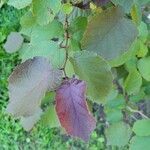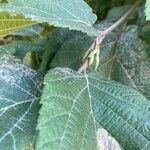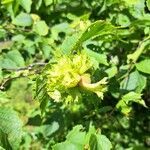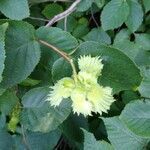Shrub 1–3 m, the young twigs and petioles ± pubescent (hairs red when young) and normally with stout, stipitate glands; lvs broadly ovate to obovate, finely doubly serrate, broadly rounded to cordate at base, paler and ± pubescent beneath; staminate catkins on short woody peduncles or branchlets; mature involucre pubescent but not bristly, 1.5–3 cm, the broad, laciniate bracts commonly separate above the nut, at least on one side; nut compressed, 1–1.5 cm, usually wider than long; 2n=22. Dry or moist woods and thickets; Me. to Sask., s. to Ga., La., and Okla.
A deciduous shrub. It grows 3 m tall. The branches are tough and flexible. The leaf stalks and twigs are covered with gland tipped hairs. The oval leaves are larger than Corylus avellana. The leaves have teeth along the edge. Male and female flowers grow on the same plant. The fruit are nuts in a fringed, green husk. The nuts are 12 mm long. They occur in clusters.





